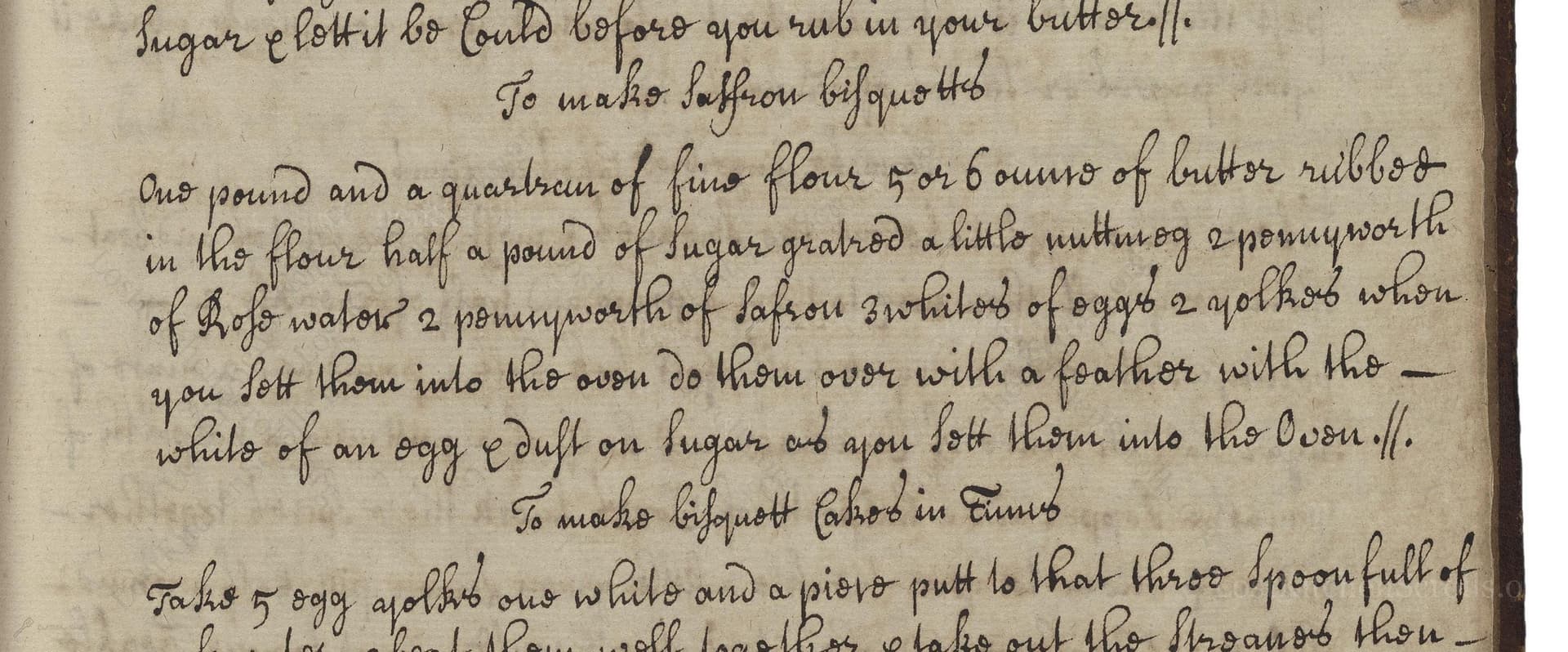To Make Saffron Bisquottes
From the treasured pages of Mrs. Rachel Kirk Book 1707
Written by Rachel Kirk

To Make Saffron Bisquottes
"One pound and a quarterun of fine flour 5 or 6 ounces of butterr rubbed in the flour half a pound of Sugar grated a little nuttmeg 2 pennyworth of Rose water 2 pennyworth of saffron 3 whites of eggs 2 yolks when you sett them into the oven do them over with a feather with the white of an egg & dust on sugar as you sett them into the oven.//"
Note on the Original Text
The original recipe was written in the early 18th-century English, notable for its unpunctuated style and flexible spelling—'quartetun' for 'quarter' (possibly a variant or scribal error), and 'do them over with a feather' meaning to brush the tops. Recipes from this era gave quantities by weight, cost ('2 pennyworth'), or common sense, expecting the cook to possess practical knowledge. The language was concise, often omitting instructions presumed familiar, such as kneading, or detailed oven temperatures, and instead relied on experience ('when you sett them into the oven'). Spelling of words like 'nutmeg', 'bisquottes', and 'quartetun' would not be standardized for another century.

Title
Mrs. Rachel Kirk Book 1707 (1707)
You can also click the book image above to peruse the original tome
Writer
Rachel Kirk
Era
1707
Publisher
Unknown
Background
A remarkable collection of early 18th-century recipes, Rachel Kirk's work invites readers into the kitchens of the past where classic culinary traditions and timeless flavors come alive. Expect a charming medley of savory feasts and sweet treats reflective of the era's sophisticated palate.
Kindly made available by
Folger Shakespeare Library
This recipe for saffron bisquottes comes from the early 18th century, specifically 1707, penned by Rachel Kirk. Saffron, once more accessible and widely used for its vibrant yellow color and distinctive floral flavor, signals a luxury or festive treat. The inclusion of rose water and nutmeg further marks the recipe as upper-class—these were costly imports. The structure, with its listing of quantities by weight and price (e.g., 'pennyworth'), reflects a period when home bakers frequently adapted commercial recipes and measured ingredients with a keen sense for economy and occasion. Bisquottes in this period referred to twice-baked or dry baked goods—biscuits or rusks, ancestry to our modern biscotti and similar sweet confections.

Rachel Kirk would have used a large wooden bowl for mixing and her hands to rub butter into flour, a common technique for combining fat and flour before the invention of modern pastry blenders. Graters for nutmeg, simple kitchen knives for shaping, eggbeaters (or forks) for whisking eggs, and 'a feather' (usually a goose quill or similar) to brush the tops with egg white were the everyday tools. Baking would have taken place in a wood-fired oven, with trays or shallow pans placed directly onto the oven's hot floor.
Prep Time
20 mins
Cook Time
20 mins
Servings
20
We've done our best to adapt this historical recipe for modern kitchens, but some details may still need refinement. We warmly welcome feedback from fellow cooks and culinary historians — your insights support the entire community!
Ingredients
- 20 ounces fine white flour
- 5 ounces unsalted butter
- 8 ounces granulated sugar
- 1/4 teaspoon freshly grated nutmeg
- 2 teaspoons rose water
- 0.018 ounce (about 1/50 oz) saffron threads (soaked in rose water; for color substitute: ground turmeric, but flavor will differ)
- 3 egg whites
- 2 egg yolks
- Extra egg white for brushing
- Extra granulated sugar for dusting
Instructions
- To make saffron bisquottes, begin by placing 20 ounces of fine white flour in a large bowl.
- Rub in 5 ounces of unsalted butter until the mixture resembles breadcrumbs.
- Add 8 ounces of granulated sugar and a pinch of freshly grated nutmeg.
- Dissolve a generous pinch of real saffron (about 1/50 ounce) in two teaspoons (2 teaspoons) of rosewater, then add this fragrant solution to the dough.
- Lightly beat three egg whites and two yolks, then mix into the flour mixture to form a soft, but not sticky, dough.
- Roll the dough 1/2–5/8 inch thick and cut into your preferred biscuit shapes.
- Before baking, brush each bisquette with lightly beaten egg white and dust with more sugar.
- Bake in a moderately hot oven (about 350°F) until golden, 15–20 minutes.
- Cool on racks and enjoy their golden color and floral, spiced aroma.
Estimated Calories
180 per serving
Cooking Estimates
You will spend about 20 minutes preparing the dough and shaping the bisquottes. Baking takes another 15–20 minutes. Each serving has about 180 calories, and this recipe makes 20 bisquottes.
As noted above, we have made our best effort to translate and adapt this historical recipe for modern kitchens, taking into account ingredients nowadays, cooking techniques, measurements, and so on. However, historical recipes often contain assumptions that require interpretation.
We'd love for anyone to help improve these adaptations. Community contributions are highly welcome. If you have suggestions, corrections, or cooking tips based on your experience with this recipe, please share them below.
Join the Discussion
Rate This Recipe

Den Bockfisch In Einer Fleisch Suppen Zu Kochen
This recipe hails from a German manuscript cookbook compiled in 1696, a time whe...

Die Grieß Nudlen Zumachen
This recipe comes from a rather mysterious manuscript cookbook, penned anonymous...

Ein Boudain
This recipe comes from an anonymous German-language manuscript cookbook from 169...

Ein Gesaltzen Citroni
This recipe, dating from 1696, comes from an extensive anonymous German cookbook...
Browse our complete collection of time-honored recipes



